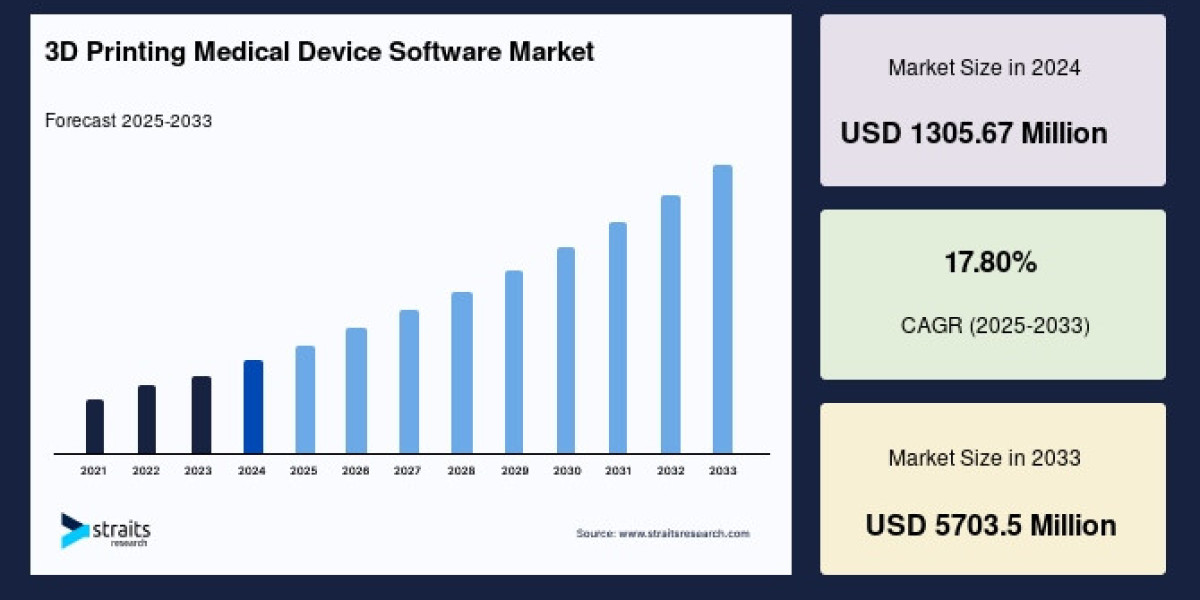The global 3D printing medical device software market is experiencing remarkable growth, driven by the increasing demand for customized and efficient healthcare solutions. Valued at USD 1305.67 million in 2024, the market is projected to grow from USD 1538.08 million in 2025 to reach USD 5703.5 million by 2033, expanding at a robust CAGR of 17.8% during the forecast period (2025–2033).
? Download Sample Report
Market Overview
3D printing in medical devices has transformed the way implants, surgical instruments, prosthetics, and tissue engineering tools are developed. Unlike traditional manufacturing, 3D printing allows layer-by-layer construction of devices directly from digital files such as CAD models or MRI scans. This adaptability makes it easier to design patient-specific devices, minimizing errors and improving treatment outcomes.
The software used in this process is crucial, as it enables designing, analyzing, visualizing, planning, simulating, and printing medical equipment efficiently. Hospitals, diagnostic centers, academic institutions, and research facilities are increasingly adopting these solutions for applications across orthopedics, spinal care, dentistry, and hearing aids.
Market Drivers
One of the primary growth drivers is the continual technical progress in software solutions. In the past, the 3D printing industry was heavily focused on hardware, but recent advances in software have streamlined workflows, reduced costs, and accelerated product development. Enhanced compatibility with CAD and imaging systems has made 3D printing more accessible for healthcare providers worldwide.
Another significant opportunity lies in direct digital fabrication (DDF), which allows parts to be manufactured directly from CAD files. This process is not only cost-effective but also speeds up the production of customized medical devices. With growing demand for patient-specific solutions, DDF is expected to play a pivotal role in the next wave of medical innovation.
However, the market faces a notable restraint in the form of constrictive regulatory directives. The U.S. FDA, for example, has approved titanium-based spinal implants but has not granted blanket approval for the use of titanium in all medical devices. This uncertainty creates compliance challenges for manufacturers and can slow down product approvals.
Regional Insights
North America remains the largest revenue contributor, expected to grow at a CAGR of 17.50%. The presence of global leaders like Stratasys and Materialise, coupled with strong research funding, supports the region’s dominance.
Europe holds the second-largest share, with Germany, the U.K., and France leading the adoption of advanced medical 3D printing software. The region’s growth is supported by private investments and innovative startups.
Asia-Pacific is projected to witness the fastest growth as global players expand operations in China and India. Startups such as Osteo3D and think3D are fueling innovation and serving international clients.
Middle East and Africa are also showing steady growth, driven by rising government and private sector investments in healthcare infrastructure.
Key Market Segmentation Highlights
By Type: Integrated software is the top contributor, enabling seamless workflow with CAD tools.
By Function: Printing dominates the market with applications in visualization and physical modeling.
By Application: Medical imaging is the largest segment, followed by dental and surgical applications.
By End-User: Medical device companies lead, supported by strong adoption in dental labs, hospitals, and research institutions.
Key Players in the Market
The market is highly competitive with established companies and emerging innovators contributing to growth. Prominent players include:
3D Systems Inc.
Materialise
Stratasys Ltd.
GENERAL ELECTRIC
EOS GmbH Electro Optical Systems
Renishaw plc.
Concept Laser GmbH
ENVISIONTEC INC.
Cyfuse Biomedical K.K.
ORGANOVO HOLDINGS, INC.
Arcam AB
3T RPD Ltd.
Recent developments further underline the market’s dynamism. For example, in March 2023, Stratasys partnered with Ricoh USA to provide print-on-demand anatomical models for clinical settings, while PD Systems expanded its digital dentistry portfolio with new materials and platforms.
Future Outlook
With the convergence of AI-driven design, precision imaging, and additive manufacturing, the 3D printing medical device software market is poised to reshape personalized medicine. Opportunities in prosthetics, surgical planning, dental care, and physical therapy will drive sustained growth. Companies that invest in regulatory compliance, cost-effective software, and advanced R&D are likely to lead the next chapter of this expanding market.
About Straits Research Pvt. Ltd.
Straits Research is a market intelligence company providing global business information reports and services. Our exclusive blend of quantitative forecasting and trend analysis provides forward-looking insight for thousands of decision-makers. Straits Research Pvt. Ltd. provides actionable market research data, especially designed and presented for decision-making and ROI. Whether you are looking at business sectors in the next town or across continents, we understand the significance of being acquainted with the client’s purchase. We overcome our clients’ issues by recognizing and deciphering the target group and generating leads with utmost precision. We seek to collaborate with our clients to deliver a broad spectrum of results through a blend of market and business research approaches.
? Phone: +1 646 905 0080 (U.S.), +44 203 695 0070 (U.K.)
? Email: sales@straitsresearch.com








